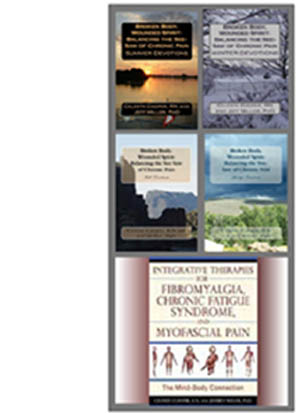If you missed "Fibromyalgia — The Past, Present, and Future:
Part I —The Past"
You can read it HERE!
*If you wish to read more on specific topics, there are links to Celeste's website
and blogs that will help give you more in-depth information
and other citations and links to follow.
Just click on the highlighted links.
The Present
According to the National Fibromyalgia and Chronic Pain Association (NFMCPA), approximately ten million Americans have been diagnosed with fibromyalgia. There is no doubt that awareness has increased over the past few years. Could it be that the FDA approving medications for fibromyalgia and the constant media attention for these medications has done this? Read fellow advocate Cort Johnson's thoughts here, and the results of a survey done by the National Pain Report here.
Even though these medications may not be what we were hoping would work, there is no denying that media attention has raised awareness, despite advertisement for boosting pharmaceutical companies bottom line. Think about the credibility fibromyalgia would have if our families, friends, peers, and even doctors knew there is scientific proof that fibromyalgia is biological syndrome and that it's not all in our heads?
biomarker – a test done on the body that indicates a specific physical trait used to assess the effects or evolution of a disease or disorder.
Widely accepted primary symptoms are:
- Body-wide pain — no longer confined to 18 tender points
- Non-restorative sleep — not feeling rested even when eight hours are achieved
- Malaise—lack of zest or energy, fatigue
- Cognitive deficit —difficulty finding words, adult onset dyslexia, and short term memory problems.
According to the 2013 AltCr (Bennett et al., 2014) other things to
consider for diagnosis include;
stiffness and tenderness to touch; balance problems; depression
and anxiety; sensitivity to lights, odors, and cold; and symptoms lasting three months or
more.

I feel very fortunate to have lived long enough to see the FM/a blood test developed, tested, and researched well. Thanks to the determination of the scientists, we now have a biomarker that shows "Unique Immunologic Patterns in Fibromyalgia." (Behm, et al.) This should come as no surprise because of the comorbid disorders.
comorbid – pertaining to two or more conditions that occur together more frequently than others.
Let's talk a bit about comorbid disorders. Irritable bowel syndrome, widely recognized as comorbid to FM is thought by many to have an immune component and that it is an organic disorder, meaning there is a biological reason that the bowel function is disrupted. Irritable bladder, interstitial cystitis, and other pelvic disorders have been closely associated with fibromyalgia, some autoimmune. Leaky gut syndrome (LGS) has been associated with FM, and we now know LGS plays a role in many autoimmune diseases, even psoriasis.
According to both the National Institute of Health and the Center for Disease Control fibromyalgia occurs as a comorbid disorder in rheumatoid arthritis, systemic lupus erythematosus, and ankylosing spondylosis. These are autoimmune diseases. In addition, did you know that osteoarthritis (thought by some to have a connection to FM) could have an immune component? Research also continues to suggest that thyroid disease is prevalent in a subset of fibromyalgia patients.
Included in the Wolfe, et al criteria (2010) was a list of "polysymptomatic and fibromyalgianess" complaints. Though it may not have been intentional, consideration of symptoms without investigating other causes, could suggest that fibromyalgia is a psychosomatic mental illness (now defined in the DSM-5 as somatic symptom disorder). Because of this, it is possible we will not get the tests, diagnosis, and treatments we need. So if you have unusual symptoms that don't respond to treatments or medications, be persistent. If you doctor is not receptive, get a second opinion.
Also not a surprise is that the sympathetic (SNS) and the autonomic nervous (ANS) systems may be in on the action. This could explain the involvement of Raynaud's, IBS, and irritable bladder. Raynaud's is thought to occur due to SNS disruption, and both IBS and irritable bladder are thought to have an immune AND sympathetic system involvement. For all the migraineurs with fibromyalgia, you will be interested to know that migraine may be due a sympathetic nervous system that has gone haywire.
Fibromyalgia has an effect on the autonomic nervous system as evidenced by research on post exertional malaise, postural orthostatic tachycardia syndrome (thought by some to also have an immune component, Li, et al.), and neurally mediated hypotension, also seen in myalgic encephalomyelitis/chronic fatigue syndrome (ME/CFS).
All these things might explain why the trigger points of myofascial pain syndrome, a peripheral pain generator in many chronic pain conditions, don't sustain treatment in fibromyalgia patients.
The following excerpt is from correspondence I had with Dr. Frederick Wolfe regarding the omission of linking comorbid conditions in the Preliminary Proposed Diagnostic Criteria.
Dr Wolfe stated: I don't share that concern or agree with you. However, the physician can certainly chose to exclude symptoms of known diseases if she chooses. That's why we ask physicians to analyze the symptoms and make a judgment. You misread the ACR criteria when you write the criteria “define symptoms of several autoimmune disorders to be considered.” The criteria refer to symptoms that are present in humans irrespective of disease. There is no clustering between FM and the diseases and syndromes you cite. FM occurs in all diseases and illnesses, but more often in diseases that cause pain or are worrisome. And it is common in osteoarthritis and back pain syndromes, which are not autoimmune at all.
Full article here.
I take issue with Dr. Wolfe's remarks because fibromyalgia is being used interchangeably with the term centralization/amplification of pain. If this is true, then Dr. Wolfe's comment makes perfect sense. However, in my opinion, fibromyalgia is NOT synonymous with centralization when centralization is considered as amplification of pain. While there is a centralization/amplification component to FM, just like there is with all chronic pain conditions, not all persons who experience chronic pain have primary symptoms of fibromyalgia or the comorbid disorders that have been identified in other research, research that Dr. Wolfe and some others fail to recognize. Also frequently neglected is the presence of myofascial pain syndrome in most, if not all chronic pain disorders. We should not be confused regarding the differences between FM and MPS. (You can watch my interview with Anthony Castelli from my website here. And, you can take a look at the plethora of research to back up my thoughts here. This is purely my opinion, and it could change, but bring me the proof.
Both the NIH and the CDC agree that fibromyalgia is prevalent in certain autoimmune disorders. You can read more on my thoughts on why Dr. Wolfe and his peers are missing important pieces to the puzzle in my blog "A Comprehensive Review on the Proposed and Modified Diagnostics for Fibromyalgia."
The proof is in the pudding
Dr. Wolfe once rebuffed the research of Dr. Albrecht, et al in his blog, Junk Science, Junk Ethics. It will be interesting to see the response to the follow up study on the Behm study, which has been done and is to be published. This follow up study shows the FM/a test is 93% effective in distinguishing fibromyalgia independent of other comparative autoimmune disorders. More importantly, the NFMCPA tells us the NIH will be using the FM/a test in fibromyalgia studies to verify diagnosis. This means that our future holds the distinction of having a biomarker, just like the other immune disorders that frequently occur with it.
Doctors Alan Light and Kathleen Light have been leading studies that show there is a specific "Gene Expression Involving Stress and Distress Pathways in Fibromyalgia with and without Comorbid Chronic Fatigue Syndrome." They believe they are close to also having a biomarker for fibromyalgia, and I understand that Dr. Robert Bennett is doing research along these same lines.
Therefore, it is with great delight that I say:
"2014 is the year that has proved without a doubt FIBROMYALGIA IS REAL!"
What does this mean for the future?
In the past, there was no biomarker, nor was there advancing research on genetic expression.
- Fibromyalgia will no longer be used as a wastebasket diagnosis (yes, it still happens).
- We won't have to endure publicized terms such as "Fibromyalgianess."
- Improvement of meeting the guidelines for disability benefits.
- Better tracking by the World Health Organization.
- Better funding for research into the biology of fibromyalgia.
- Target rich treatments.
While having a biomarker is important until we find a cure, we will still need to use approaches for coping with chronic illness and pain. Many disorders have biomarkers, such as MS, SLE, RA, diabetes, etc., but these patients still struggle to maintain, and many of them are also fibromyalgia patients. In every case, patient outcome is based on learning to live life the best we can despite illness.
My suspicion is that once we understand the pathophysiology behind autoimmune disorders, we will be able to make great strides for prevention. It's not just about us, it's about future generations.
That's what gives us courage, determination, and hope.
Resources
Ahmad J1, Tagoe CE. Fibromyalgia and chronic widespread pain in autoimmune thyroid disease. Clin Rheumatol. 2014 Jan 18. [Epub ahead of print]
Alonso-Blanco C, Fernández-de-las-Peñas C, Morales-Cabezas M, Zarco-Moreno P, Ge HY, Florez-García M. Multiple active myofascial trigger point reproduce the overall spontaneous pain pattern in women with fibromyalgia and are related to widespread mechanical hypersensitivity. Clin J Pain. 2011 Jun;27(5):405-13.
American Psychiatric Association (APA) - DSM-5. Characteristics of Somatic Symptom Disorder.
http://www.dsm5.org/Documents/Somatic%20Symptom%20Disorder%20Fact%20Sheet.pdf (Accessed 5-30-2014).
Behm FG, Gavin IM, Karpenko O, Lindgren V, Gaitonde S, Gashkoff PA, Gillis BS. Unique immunologic patterns in fibromyalgia. BMC Clin Pathol. 2012 Dec 17;12(1):25. doi: 10.1186/1472-6890-12-25.
http://www.dsm5.org/Documents/Somatic%20Symptom%20Disorder%20Fact%20Sheet.pdf (Accessed 5-30-2014).
Behm FG, Gavin IM, Karpenko O, Lindgren V, Gaitonde S, Gashkoff PA, Gillis BS. Unique immunologic patterns in fibromyalgia. BMC Clin Pathol. 2012 Dec 17;12(1):25. doi: 10.1186/1472-6890-12-25.
Bennett RM, Goldenberg DL. 2011. Fibromyalgia, myofascial pain, tender points and trigger points: splitting or lumping? Arthritis Res Ther. 2011 Jun 30;13(3):117.
Bennett R, Friend R, Marcus D, Bernstein C, Han BK, Yachoui R, Deodar A, Kaell A, Bonafede P, Chino A, Jones K. Criteria for the diagnosis of fibromyalgia: Validation of the modified 2010 preliminary ACR criteria and the development of alternative criteria. Arthritis Care Res (Hoboken). 2014 Feb 4. doi: 10.1002/acr.22301. [Epub ahead of print]
H C Chandola and Arunangshu Chakraborty. Fibromyalgia and Myofascial Pain Syndrome-A Dilemma. Indian J Anaesth. Oct 2009; 53(5): 575–581.PMCID: PMC2900090
Cho KI1, Lee JH. The impact of thyroid autoimmunity on arterial stiffness in postmenopausal patients with fibromyalgia. Int J Rheum Dis. 2014 Jan 11. doi: 10.1111/1756-185X.12257. [Epub ahead of print]
Cooper C and Miller J. (2010). Integrative Therapies for Fibromyalgia, Chronic Fatigue Syndrome, and Myofascial Pain: The Mind-Body Connection. Vermont: Healing Arts Press.
da Cunha Ribeiro RP, Roschel H, Artioli GG, Dassouki T, Perandini LA, Calich AL, de Sá Pinto AL, Lima FR, Bonfá E, Gualano B. Cardiac autonomic impairment and chronotropic incompetence in fibromyalgia. Arthritis Res Ther. 2011 Nov 18;13(6):R190.
Fernandez-de-Las-Penas C, Penacoba-Puente C, Cigaran-Mendez M et al. Has catechol-O-methyltransferase genotype (Val158Met) an influence on endocrine, sympathetic nervous and humoral immune systems in women with fibromyalgia syndrome? Clin J Pain. 2014.30(3):199-204.
Giovanni Barbara,corresponding author Cesare Cremon, Giovanni Carini, Lara Bellacosa, Lisa Zecchi, Roberto De Giorgio, Roberto Corinaldesi, and Vincenzo Stanghellini. The Immune System in Irritable Bowel Syndrome J Neurogastroenterol Motil. Oct 2011; 17(4): 349–359. Published online Oct 31, 2011. doi: 10.5056/jnm.2011.17.4.349 PMCID: PMC3228974
Kitagawa Y, Kimura K, Yoshida S. Spectral analysis of heart rate variability during trigger point acupuncture. Acupunct Med. 2014. [Mar 7 Epub ahead of print.]
Küçükşen S, Genç E, Yılmaz H, Sallı A, Gezer IA, Karahan AY, Salbaş E, Cingöz HT, Nas O, Uğurlu H. The prevalence of fibromyalgia and its relation with headache characteristics in episodic migraine. Clin Rheumatol. 2013 Feb 27.
Lepus CM1, Song JJ, Wang Q, Wagner CA, Lindstrom TM, Chu CR, Sokolove J, Leung LL, Robinson WH. Brief report: carboxypeptidase B serves as a protective mediator in osteoarthritis. Arthritis Rheumatol. 2014 Jan;66(1):101-6. doi: 10.1002/art.38213.
Li H1, Yu X, Liles C, Khan M, Vanderlinde-Wood M, Galloway A, Zillner C, Benbrook A, Reim S, Collier D, Hill MA, Raj SR, Okamoto LE, Cunningham MW, Aston CE, Kem DC.
Autoimmune basis for postural tachycardia syndrome. J Am Heart Assoc. 2014 Feb 26;3(1):e000755. doi: 10.1161/JAHA.113.000755.
Light KC, White AT, Tadler S, Iacob E, Light AR. Genetics and Gene Expression Involving Stress and Distress Pathways in Fibromyalgia with and without Comorbid Chronic Fatigue Syndrome. Pain Res Treat. 2012;2012:427869. Epub 2011 Sep 29.
Light AR, Bateman L, Jo D, Hughen RW, Vanhaitsma TA, White AT, Light KC. Gene expression alterations at baseline and following moderate exercise in patients with Chronic Fatigue Syndrome and Fibromyalgia Syndrome. J Intern Med. 2011 May 26. doi: 10.1111/j.1365-2796.2011.02405.x. [Epub ahead of print]
Doctors Alan Light and Kathleen Light from the Anesthesiology Department at the University of Utah. Sufferers of chronic fatigue, fibromyalgia have hope in new diagnostic tool.
http://www.deseretnews.com/article/865603384/Sufferers-of-chronic-fatigue-fibromyalgia-have-hope-in-new-diagnostic-tool.html (accessed 5-25-2014).
Magdy El-Salhy, Doris Gundersen, Odd Helge Gilja, Jan Gunnar Hatlebakk, and Trygve Hausken Is irritable bowel syndrome an organic disorder? World J Gastroenterol. Jan 14, 2014; 20(2): 384–400. Published online Jan 14, 2014. doi: 10.3748/wjg.v20.i2.384
PMCID: PMC3923014
Martínez-Martínez LA1, Mora T, Vargas A, Fuentes-Iniestra M, Martínez-Lavín M. Sympathetic nervous system dysfunction in fibromyalgia, chronic fatigue syndrome, irritable bowel syndrome, and interstitial cystitis: a review of case-control studies. J Clin Rheumatol. 2014 Apr;20(3):146-50. doi: 10.1097/RHU.0000000000000089.
Peroutka SJ. Migraine: a chronic sympathetic nervous system disorder.Headache. 2004 Jan;44(1):53-64.
Wolfe F, Walitt BT, Katz RS et al. Symptoms, the nature of fibromyalgia, and diagnostic and statistical Manual 5 (DSM-5) defined mental illness in patients with rheumatoid arthritis and fibromyalgia. PLoS One. 2014. 9(2):e88740.
Wolfe F, Brähler E, Hinz A, Häuser W.Arthritis Care Res (Hoboken).Fibromyalgia prevalence, somatic symptom reporting, and the dimensionality of polysymptomatic distress: Results from a survey of the general population. 2013 Feb 19. doi: 10.1002/acr.21931. [Epub ahead of print]
Wolfe F1, Michaud K, Busch RE, Katz RS, Rasker JJ, Shahouri SH, Shaver TS, Wang S, Walitt BT, Häuser W. Polysymptomatic Distress in Patients with Rheumatoid Arthritis: Understanding disproportionate response and its spectrum. Arthritis Care Res (Hoboken). 2014 Feb 4. doi: 10.1002/acr.22300. [Epub ahead of print]
Wolfe F, Clauw DJ, Fitzcharles MA, Goldenberg DL, Katz RS, Mease P, Russell AS, Russell IJ, Winfield JB, Yunus MB. The American College of Rheumatology preliminary diagnostic criteria for fibromyalgia and measurement of symptom severity. Arthritis Care Res (Hoboken). 2010 May;62(5):600-10.
Wolfe F, Clauw DJ, Fitzcharles MA, Goldenberg DL, Katz RS, Mease P, Russell AS, Russell IJ, Winfield JB, Yunus MB. The American College of Rheumatology preliminary diagnostic criteria for fibromyalgia and measurement of symptom severity. Arthritis Care Res (Hoboken). 2010 May;62(5):600-10.
Wolfe F, Clauw DJ, Fitzcharles MA, Goldenberg DL, Häuser W, Katz RS, Mease P, Russell AS, Russell IJ, Winfield JB: Fibromyalgia Criteria and Severity Scales for Clinical and Epidemiological Studies: A Modification of the ACR Preliminary Diagnostic Criteria for Fibromyalgia. J Rheumatol 38;1113-1122, 2011.
Frederick Wolfe. Fibromyalgianess. Arthritis Care and Research. DOI: 10.1002/art.24553 Article first published online: 28 MAY 2009
http://onlinelibrary.wiley.com/doi/10.1002/art.24553/full
Frederick Wolfe. Fibromyalgianess. Arthritis Care and Research. DOI: 10.1002/art.24553 Article first published online: 28 MAY 2009
http://onlinelibrary.wiley.com/doi/10.1002/art.24553/full
Yun DJ, Choi HN, Oh GS. 2013. A case of postural orthostatic tachycardia syndrome associated with migraine and fibromyalgia. Korean J Pain. 26(3):303-306.
"Adversity is only an obstacle if we fail to see opportunity." Celeste Cooper, RN
Author, patient/ advocate, fibromyalgia health expert
Books:
Read about Celeste and access to her books at Author Central here
Broken Body, Wounded Spirit: Balancing the See Saw of Chronic Pain [Four book series]
Integrative Therapies for Fibromyalgia, Chronic Fatigue Syndrome, and Myofascial Pain
Website: http://www.TheseThree.com
~ • ~ • ~ • ~ • ~ • ~
All answers and blogs are based on the author's opinions and
writing and are not meant to replace medical advice.














1 comment:
Well done! Great information shared here. Thanks for sharing. children irritable bowel syndrome
Post a Comment